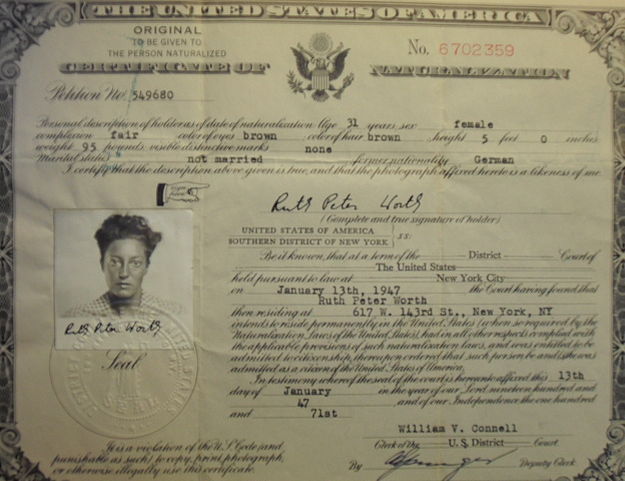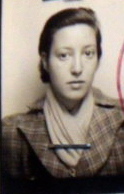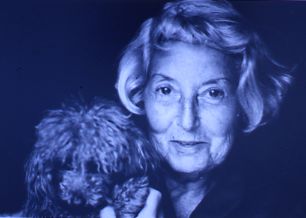Ruth Peter Worth (April 10, 1915 - February 7, 1997)
By Jonathan Ned Katz with research assistance, German translations, photos, and written summaries by volunteer Ron Van Cleef.
The Life of Ruth Peter Worth
Ruth Peter Worth (originally, Ruth Wertheimer), was a Jewish Holocaust survivor, U.S. immigrant, lesbian, and long-time home owner in Cherry Grove, Fire Island, New York.[1]
Below: Worth's U.S. Naturalization Document Using Name "Ruth Peter Worth".[2]
Ruth was born into a well-to-do family in Halberstadt, Germany on April 10, 1915. While she was still a child her family moved to Berlin, where she was raised. Her mother's family owned a corset manufacturing and repair company with approximately five stores that served an upscale clientele. After Ruth's father, Leopold Wertheimer, died in 1918, her mother, Elli (also called Elly and Ellen) Bendix married Israel Rosenfeld, a film producer. At some point, Ruth shortened and Anglicized her birth-father's last name to Worth.
Below: Worth's Passport Photo.[3]
As a young woman, Ruth, aware that her sexual attraction was for women, started adding Peter to her name, and sometimes used Peter as her first name. This was a verbal way of publicly signifying her orientation to other like-minded women and men. As a visual signal of her erotic and affectional interest she also sometimes wore a man's tie, although her figure was slight and her clothes and demeanor throughout her life were otherwise traditionally feminine.[4]
Starting in the late-1920s, Ruth and other family members suffered anti-semitism. In the spring of 1932, Ruth attended the Rackow Handelsschule in Berlin where the anti-semitism of her teachers and classmates forced her to leave before completing her two-year program. She was disappointed as she had hoped to gain a senior-level position in industry or commerce after graduating. In 1935, Ruth attended a new trade school in Berlin, the Fuerstin–Bismarck School, where she became friends with Edith Margot Alexander (later Certe).[5]
On November 16, 1938, Worth left Germany for Paris, France. Her German passport, of that date, is stamped "J" for Jew. She possibly left Germany as a result of Kristallnacht (the Nazi-organized Crystal Night attack on Jews and Jewish businesses, that had occurred on November 9 and 10, 1938.
According to the recollection of anthropologist Esther Newton, who interviewed Worth, "after Peter and her mother went to Paris they were interned, along with many other German refugees, most or all of whom were Jewish, in a concentration camp called Gurs. Ironically, during this period, before the German invasion of France, these people were considered 'aliens'. [Newton suggests that this incarceration was perhaps just an excuse to punish the German Jews.] According to what Peter told me, she developed a flirtation (or perhaps more) with one of the female guards or administrators who then helped them to get out." Worth's papers in the Baeck Institute contain a document headed: "Avis De Libération Du Camp D'internement De Gurs, 21 June 1940", providing evidence of her incarceration.
By December 24, 1940, Worth and her family were planning their departure from France to the United States. In a letter addressed to Worth and her mother, her uncle, William Bendix, already in Jackson Heights, Queens, wrote that he had petitioned the "Emergency Committee" on their behalf. He stated that the Committee normally only reviewed political cases, but they were considering Worth and her mother because their family members were involved with the Anti-Nazi League and the German Democratic Party (Worth’s uncle William described himself as a leading or founding member).[6]
On July 1, 1941, the apparently desperate Worth and/or her mother wrote an angry letter to William Bendix, chastising him for holding up their visas to leave France. The letter suggested that Bendix was concerned about receiving repayment for the women's asylum applications. The writers remind him that they are facing a “life and death” situation.
As Esther Newton recalls, in 1941, Worth and her mother made their way to Portugal and from there embarked for America.
Worth and her mother emigrated to the United States and settled in New York City. "Ruth Peter Worth" is listed in the U.S. Naturalization Record Indexes as applying for citizenship under that name in New York District Court. Worth's inclusion of the male name "Peter" on her "Naturalization Record" seems an extraordinary act of resistance that asserted her lesbian orientation, in coded form, in the face of severe state, institutional, and cultural sanctions that constituted lesbianism as "unnatural".
Worth found clerical employment at City College in New York City between 1943 and 1949, and from 1949 to 1958 she worked at Hunter College, where, Esther Newton recalls, Worth was an administrative secretary in one of the departments. Newton remembers: "She was a humble person and never expressed resentment to me about being overqualified for the job."
Around 1946, Worth bought a small house in Cherry Grove, Fire Island, New York, then a little-known community of lesbians and gay men. She occupied that house every summer and became a slight, quiet member of the community who walked her beloved dog and was known to everyone as "Peter".
On August 29, 1986, Worth was one of the Cherry Grove inhabitants interviewed by anthropologist Esther Newton for her history of Cherry Grove, published in August 1993, which contains 26 references to Worth. Newton reports that Worth, "despite having somewhat left wing politics, was intensely patriotic, and whenever I would criticize some Reagan policy she would remind me that America gave her refuge and that there was no place else, she thought, where 'gay girls and boys' could be so free".
Worth was also was interviewed by Katherine Linton about her life's journey for "In the Life", the LGBT TV magazine produced in New York City, and that show first aired on October 27, 1996 when Worth was 81. A reviewer of that show said: "her spirit still lives in the irrepressible humor of her eyes, captured for posterity by the 'In the Life' video cameras."
Philis Raskind recalls that in 1991, when she became a summer renter in Cherry Grove, "I noticed this quiet, interesting looking older woman, [Peter Worth] who walked around the community every morning with her little miniature poodle, Cherry. Even though I would say hello to her each day she never did more than nod at me. Deciding to make her acquaintance, I knew the way to her heart was through Cherry. I began to carry treats with me and would stop and pet the dog who immediately looked for me on their walks. Finally, Peter started talking to me!"
In 1996, Raskind purchased a home in Cherry Grove that she shared with her "closest friend", Jon Anderson, and his long-time lover, the painter Paul Cadmus. Raskind's home was close to Peter's home, and "We became close friends . . . ." Peter "told me her first sexual encounter with another woman was on her voyage to America."
Raskind "was aware that Peter never wanted to live past the point where she could not care for herself." She recalls Peter leaving the island to visit her mother, who lived in New York until she died at an extremely advanced age.
As she grew older, Worth saw elderly friends become incapacitated and helpless, despite their earlier stated desire to end their lives before such a fate. Worth therefore had her hair done, put on her favorite outfit (a pair of beige slacks, a pale blouse and a vest and shoes), and left a phone message for Philis Raskind "that little Cherry was at such and such kennel and if I did not hear from her in a few days to please take care of her." Peter sat down on the bed in her New York City apartment where she took the pills that ended her life. She died on February 7, 1997. As Raskind recalls, Worth was found "sitting (a bit tilted) on her bed with a pad and pencil in hand" -- as if trying to write one last message to the world. Raskind and friends found a home for Cherry who lived for many, many years after her mistress.[7]
Having applied for and received monetary compensation from the German government for property confiscated and income lost due to the Nazi regime, in her will Worth was able to leave a large donation to the Lambda Legal Defense & Education Fund, the national organization committed to achieving full recognition of the civil rights of lesbians, gay men, bisexuals, transgender people and those with HIV.
She also left a significant bequest to SAGE, the country's largest and oldest organization dedicated to improving the lives of lesbian, gay, bisexual and transgender (LGBT) older adults.
Worth made Esther Newton her literary executor, and Newton donated Worth's papers to the Baeck Institute, a Jewish history archive in New York City.
After hearing the disturbing news of Worth's death, months later her friend Amber Hollibaugh was surprised and delighted to receive news that Worth, without telling anyone of her plans, had left Hollibaugh her Cherry Grove home.
Photo of Peter Worth by Betsy Haight.[8]
See also:
Ruth Peter Worth Bibliography
Ruth Peter Worth Chronology by Ron Van Cleef
Nazi Persecution of Homosexuals: Bibliography
Notes
- ↑ OutHistory.org officially published this entry on October 31, 2011. The release was headed: "Jewish, Holocaust Survivor, Immigrant, Cherry Grover, Lesbian" and the subhead read: "OutHistory.org Publishes Research on Ruth Peter Worth". The main text read: "On the last day of LGBT History Month 2011, OutHistory.org is publishing a biography and original research about a woman who, on her U.S. naturalization application, called herself “Ruth Peter Worth”. Worth's inclusion of the male name “Peter” on her U.S. "Certificate of Naturalization" was an act of resistance that asserted the naturalness and goodness of her lesbian desire and identity. Historian Jonathan Ned Katz makes that point in Worth's biography on OutHistory. This biography of Worth includes a large copy of her “Certificate of Naturalization” and a late photograph of Worth, born in Germany, in a Jewish family, who was a survivor of the Holocaust, a U.S. immigrant, a home owner in Cherry Grove, Fire Island, and a lesbian who went public with her story at age 81.
- ↑ Document in Baeck Institute.
- ↑ Document in Baeck Institute.
- ↑ As reported by Esther Newton. Citation ????
- ↑ The Fuerstin-Bismark school was in the Berlin district of Charlottenburg. The original school is gone and a later one was built in the 1950s. See: Center for Jewish History. Digital Collections. Fuerstin-Bismarck-Schule, Berlin, 1916-1939.
- ↑ It is likely that the Committee referred to is Varian Fry’s famous Emergency Committee. That organization helped hundreds of Jews, mainly intellectuals, escape France. The committee faced strict limitations by the Roosevelt Administration, as critics of the program felt it would lead to job competition and political subversion in the United States.
- ↑ Information provided by Philis Raskind and Amber Hollibaugh.
- ↑ From the Collection of Esther Newton.
Last edited: July 17, 2012 by Jonathan Ned Katz


